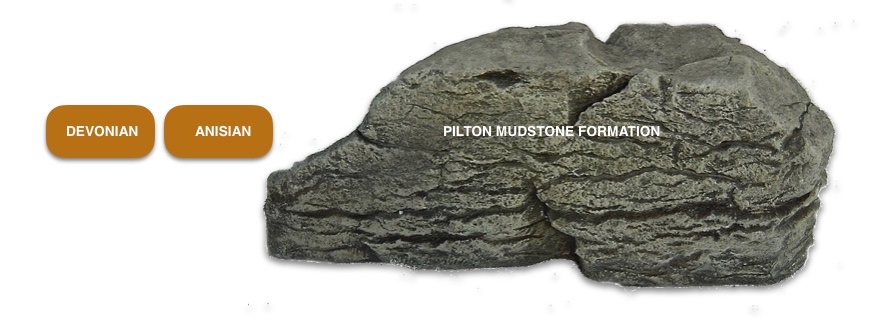Along the banks of the River Taw at Fremington, rocks from the Devonian age can be seen packed with brachiopods and bivalves. The site is easy to access and makes a wonderful day out. All you need is a good eye and to stroll along the banks.
DIRECTIONS
♦ Take the B3233 to Fremington. From here, look out for a signpost for ‘Fremington Quay’. This is a long, narrow road, which tends to be quite busy. However, there are few passing places.
♦ This road will take you right onto the quay. You will pass a cafe and bike hire shop, before the road ends at a small car park.
♦ Park here and there is a footpath down to the beach, where you can just make out the small cliffs in the distance. You can also collect fossils from the rocks along the foreshore
♦ Ref: 51.08109°N, 4.11894°W
PROFILE INFO
FIND FREQUENCY: ♦♦ – Fossils are mostly found by walking along the foreshore and examining the rocks.
CHILDREN: ♦♦♦♦ – This location is suitable for families with children and can make an ideal family day out, with bicycle hire nearby.
ACCESS: ♦♦♦♦ – There is an excellent car park with toilets and cafe. It is also a very short walk to the beach.
TYPE: – Fossils are found in rocks scattered on the foreshore. There are also cliffs here, but you are not likely to find any fossils in these and the low cliffs are quite overgrown.
FOSSIL HUNTING
There are a wide variety of rocks scattered along the foreshore at Fremington and you never know what you might come across. Devonian shells are quite common and usually found in large lumps of rock. However, there is very little evidence of fossils in the cliff itself, with the fossiliferous beds either coming from bedrock washed from the bottom of the river from further upstream.
Keep an eye open for Carboniferous rocks, composed of limestone. These tend to be very hard and are usually packed with shells. Many bivalves and other shells can also be found and are usually in good condition. Most fossils from Fremington come from these blocks. These will need to be split if you can find any.

GEOLOGY
The site is designated as a Site of Special Scientific Interest(SSSI). The natural exposure in the region shows a unique sequence through the Devonian-Carboniferous boundary with important palaeontological information of international importance.
The cliff section north of Fremington Quay provides stratigraphical evidence for uninterrupted marine sedimentation in North Devon across the Devonian-Carboniferous boundary. The more northerly
exposures show Devonian (Fammenian) shaly mudrocks with a sparse fauna, including characteristic trilobites. The Carboniferous rocks can also be found on the foreshore, washed down from further upstream.
The Devonian rocks are part of the Pilton Mudstone Formation, of the Famennian stage. These are grey mudstones and siltstones, with thin to thick-bedded, locally calcareous sandstones and lenses of limestone. Sandstones make up the thickest layers and predominate in the lower half of the formation, whereas mudstones predominate in the upper half. A rich, shelly neritic (coastal) fauna can be found in the mudstones and limestones. Higher levels to the south show a sequence of very early Carboniferous faunas in which small brachiopods and trilobites are frequent.Pebbly deposits interpreted as either an interglacial raised beach or fluvioglacial deposits, overlying Carboniferous bedrock in the low cliffs west of Fremington Quay.
Additional exposures west of Fremington Quay showing silty and stony Quaternary deposits overlying Quaternary bedrock. Some of these deposits have been interpreted as glacial till.


SAFETY
Common sense when collecting at all locations should be used and prior knowledge of tide times is essential. Fremington is tidal and you can easily be cut off at high tide. Be careful of areas of mud beside the river and do not venture too far into these as you could get stuck.
EQUIPMENT
A large lump hammer, a chisel and safety goggles are required, and stout footwear is advised. The rocks here are very hard indeed, so it may be a good idea to sharpen hammers before any visit to Croyde, as the slate is difficult to split. The fossils are also quite hard in the slate, but once the rock is split into sizeable pieces, it can become brittle and so fossils should be wrapped up well. As this is an SSSI, do not hammer the bedrock or cliffs.
EQUIPMENT
Fossils here are very hard. Therefore, you will need a heavy hammer, a chisel and safety goggles to split some of the rocks and a good eye to look for any carboniferous limestone blocks lying on the beach.
ACCESS RIGHTS
This site is an SSSI. This means you can visit the site, but hammering the bedrock is not permitted. For full information about the reasons for the status of the site and restrictions please download the PDF from Natural England – SSSI Information – Fremington
It is important to follow our ‘Code of Conduct’ when collecting fossils or visiting any site. Please also read our ‘Terms and Conditions‘
LINKS
♦ Buy Fossils, Crystals, Tools
♦ Location Discussions
♦ Deposits Magazine
♦ Join Fossil Hunts
♦ UK Fossils Network


















